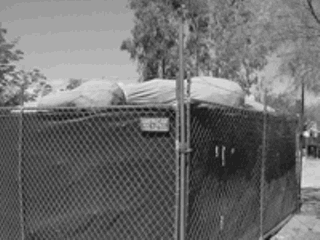Designed as liquid rock but widely interpreted by nearby residents as raw sewage, the two works--"Splash" and "Pipe With Flow 30"--are now surrounded by chain-link fencing and brown tarps made necessary after a tagger added a phallus motif last month.
The $106,000 art project, part of a long-overdue drainage project along Mountain Avenue between Grant and Fort Lowell roads, floated to the forefront of controversy this spring when neighbors objected to its brown color. In April, after residents voted against keeping the sculptures by a 2-1 margin in an informal poll, city officials announced they would remove the artwork.
The transportation department is now looking for a new home for the two pieces. The Prince-Tucson neighborhood is surveying residents to determine if there's interest in relocating the sculptures near the banks of the Rillito River, says transportation department spokesman Michael Graham.
Most of the blame in the Mountain Avenue affair has been laid on a communications breakdown since the commission was originally awarded in 1995. Because of the delay, the artwork's design was never incorporated into a more recent series of public meeting process regarding the roadwork. When the sculptures were installed, neighbors got their first look at the art. Critical reaction was scathing, to say the least.
To head off future squabbles, officials are now reviewing the city's public art selection process.
Last week, Councilwoman Kathleen Dunbar opened her Ward 3 office to an open discussion on proposed changes to the current city policy, which calls for setting aside 1 percent of construction budgets for public art and beautification. (Although the transportation department is not bound by the policy, it participates voluntarily with many projects, such as artist Steve Farley's photographic tile work in the Broadway Boulevard underpass at the east entrance of downtown.)
Since 1986, the city has commissioned more than 80 projects through the Tucson-Pima Arts Council, a nonprofit agency that supports the local arts. For each city project, TPAC officials issue a call to artists, who submit conceptual pitches to a seven-member selection committee made up of two artists, two community representatives, a staffer from the city department funding the project, a member of the project design team and an arts professional who is not a practicing artist. Generally, artists don't provide much more than a conceptual framework for the piece; often, an artist's track record can be as important as the idea submitted.
Once the selection committee chooses an artist, it has no real oversight on the project. Artists generally work with the city department funding the project from that point.
Dunbar, who stresses her support for public art, is pushing three changes to the current policy:
· Representatives from any neighborhood connected to the artwork would be included on an expanded selection committee;
· After their selection, artists would present models or sketches of the artwork in public meetings before beginning to install the artwork;
· The call to artists wouldn't occur until the city had funding for projects.
The final provision worries the city's transportation director, Jim Glock, who says the new guidelines would have made it impossible, for example, to apply for the federal funds that paid for the new Diamondback Bridge downtown.
But the other changes are meeting with little resistance. Karen Falkenstrom of Tucson-Pima Arts Council says the organization supports more public outreach on the projects. The organization welcomes the opportunity to revise its directives, which date back more than a decade.
Artist Paul Edwards, whose designed the Mountain Avenue sculptures, hopes that the new approach would prevent similar explosions the future.
"I'll be proud to have been part of this debacle is something good comes out of this," Edwards says.
But one question remains, raised by audience member Ann Charles: What happens if, one day, the artist insists on pushing ahead with a project that neighbors object to?
"There has to be an appeals process, and I'm not sure what that is," Dunbar says. "I think it needs more work."
But Dunbar hopes that with more community involvement, future projects will never reach such a contentious stage.
"If you have the open houses and you have the buy-in, you won't ever get to an appeals process," she says.
Mike Jenkins, a Republican seeking to unseat Democrat Shirley Scott, attended the meeting and afterwards questioned any funding for public art. "These are tight times," he says. "When you can't pay for your basics, why are you spending money on art?"
David Hoyt Johnson, associate director of the Tucson-Pima Arts Council, replies: "That is a tough question, because in this country, there is not a strong tradition of public funding for art."
Even most public art works, such as memorials and equestrian statues, were funded by civic groups, not taxpayers. The major exception came during the Great Depression, when federal programs put murals in post offices and hospitals.
The current movement in public art has its roots in the 1960s, according to Johnson. "Increasingly, the public has been recognizing that artistic enhancements do improve public works--plazas and bridges and the railings might be better designed by an artist than taken from a catalogue," he says. "But that's not a widespread position and it's held by fewer citizens in hard economic times."
But the payoff for the community is worth the expense, argues Johnson. "One percent is not a lot to give some identity to a community, make it more attractive," he says.















